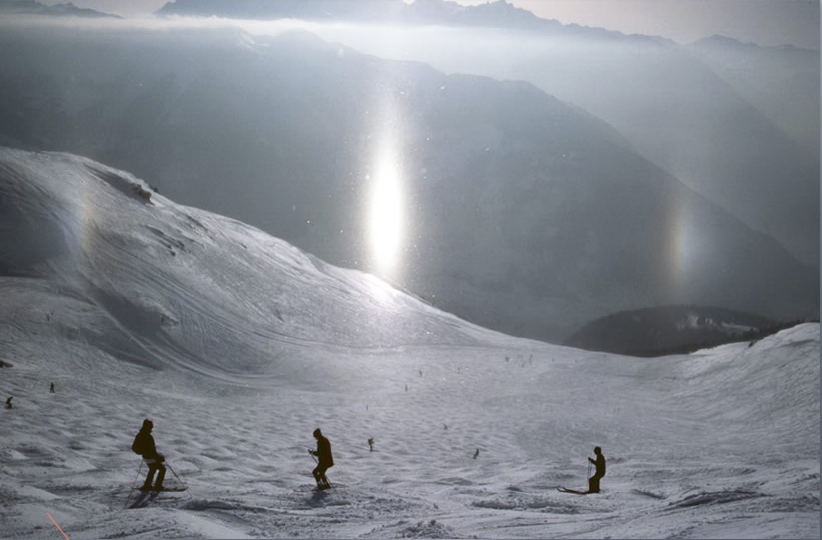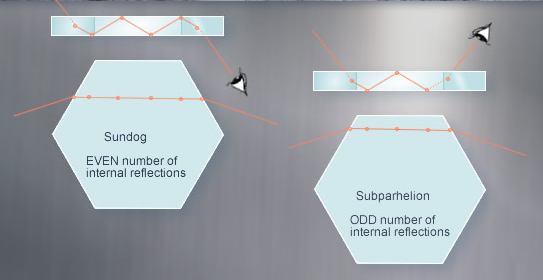Below the Horizon
Below the Horizon: Exploring Sub-Horizon Halos and Subparhelia
Have you ever witnessed a breathtaking optical phenomenon in the sky, just below the horizon? These captivating displays, known as sub-horizon halos, add an extra touch of magic to our atmospheric optics experiences. In this article, we will delve deeper into the fascinating world of sub-horizon halos and their mesmerizing components, such as subsuns and subparhelia.
Sub-horizon halos are formed by diamond dust crystals, which create a spectacle that often goes unnoticed due to their location just below the horizon. These halos are composed of various optical phenomena, including a central subsun and prismatic subparhelia. The subsun is situated at the same distance below the horizon as the sun is above it. Its formation occurs through the direct reflection of sunlight by the upper and lower near-horizontal faces of plate crystals.
While subparhelia are often mistaken for sundogs, they are actually distinct phenomena. Sundogs are produced by light from the subsun, which can be overwhelmingly bright at times. On the other hand, subparhelia are glints of light that result from individual light rays passing through a single crystal. Each glint is formed through a unique path, adding to the complexity and beauty of these sub-horizon halos.
The formation of subparhelia involves intricate internal reflections within the crystal. When light enters a side face of the crystal, it is reflected internally from the top and bottom faces an odd number of times. The ray then exits through another side face inclined at an angle of 60° to the first face. This odd number of reflections directs the ray upwards, causing the subparhelion to appear beneath the horizon.
It is important to note that sundogs can also be formed by similarly internally reflected rays, with one key difference: an even number of reflections produce a sundog. The interplay between the number of reflections and the resulting optical phenomena creates a captivating dance of light in the sky.
To truly appreciate the wonder of sub-horizon halos and subparhelia, it is best to observe them when the sun is not near the horizon. This allows for a clearer view of these phenomena, as their visibility can be diminished when they are in close proximity to the sun. By seeking out these optical marvels at the right time and under the right conditions, you can witness the full splendor of sub-horizon halos and their intricate components.
In conclusion, sub-horizon halos and their mesmerizing elements, such as subsuns and subparhelia, add an enchanting touch to our atmospheric optics experiences. The interplay between diamond dust crystals and sunlight creates a spectacle that often goes unnoticed, hidden just below the horizon. By understanding the intricate formations and reflections involved, we can fully appreciate the beauty and complexity of these captivating optical phenomena. So keep your eyes to the sky, for there is a world of wonder waiting just below the horizon.

Sub-horizon Halos imaged by Rob Noble at Verbier, Switzerland. ©Rob Noble, shown with permission.
Formed by diamond dust crystals, a central subsun is flanked by prismatic subparhelia (sub sundogs).

Subsuns are the same distance below the horizon as the sun is above. Direct reflection of the sun by the upper and lower near horizontal faces of plate crystals forms them.
Subparhelia are often thought to be sundogs produced by light from the often blindingly bright subsun. Not so. The glints that make up ice halos are each from light rays that have passed through one crystal only.
Subparhelia result when light enters a crystal side face, is reflected internally from the top and bottom faces an ODD number of times and then leaves another side face inclined at 60° to the first. The odd number of reflections directs the ray upwards and so the parhelion appears beneath the horizon.
Except when the sun is near the horizon, sundogs are also formed by rays that are similarly internally reflected. The difference is that an EVEN number of reflections produce a sundog.
Note: this article has been automatically converted from the old site and may not appear as intended. You can find the original article here.
Reference Atmospheric Optics
If you use any of the definitions, information, or data presented on Atmospheric Optics, please copy the link or reference below to properly credit us as the reference source. Thank you!
-
<a href="https://atoptics.co.uk/blog/below-the-horizon/">Below the Horizon</a>
-
"Below the Horizon". Atmospheric Optics. Accessed on April 26, 2024. https://atoptics.co.uk/blog/below-the-horizon/.
-
"Below the Horizon". Atmospheric Optics, https://atoptics.co.uk/blog/below-the-horizon/. Accessed 26 April, 2024
-
Below the Horizon. Atmospheric Optics. Retrieved from https://atoptics.co.uk/blog/below-the-horizon/.